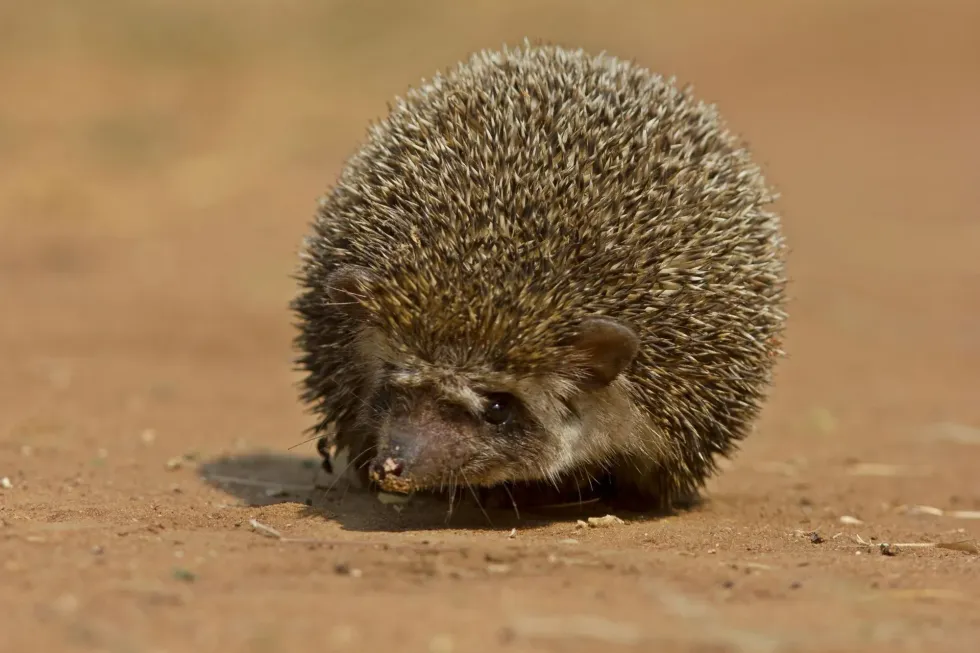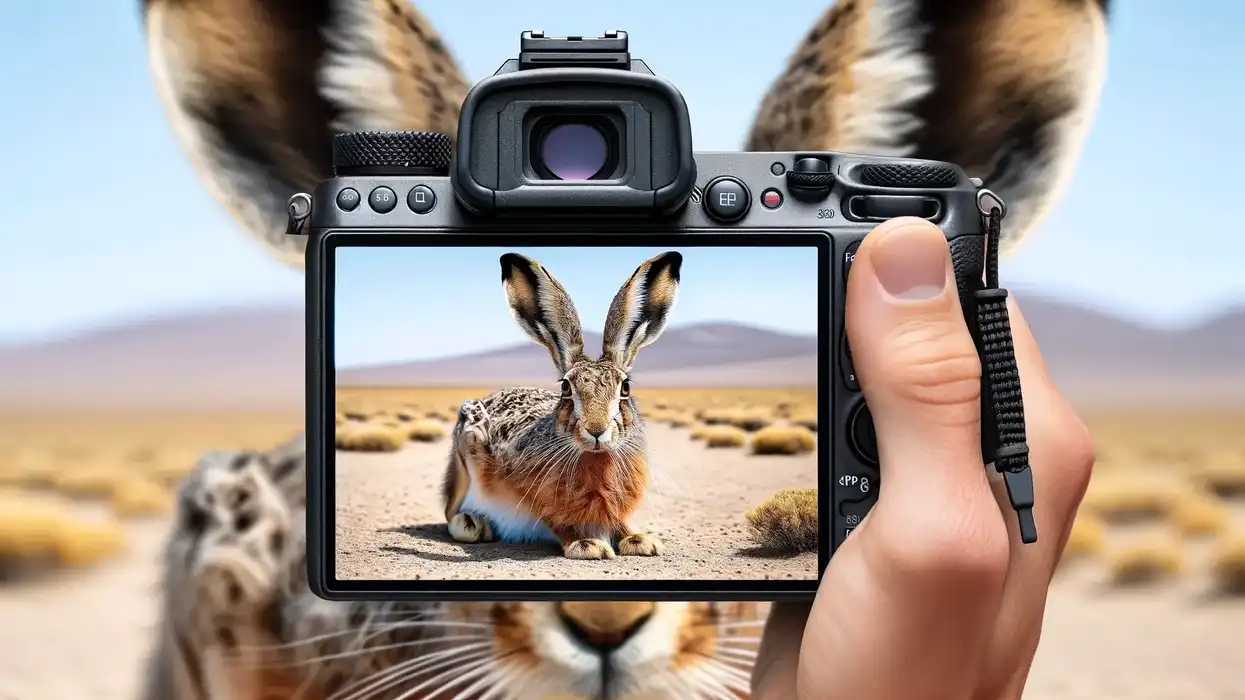The Indian hedgehog (Paraechinus micropus) is a type of hedgehog endemic to the countries of India and Pakistan. They are mostly found in arid deserts, thorn forests, and irrigated farmlands in these countries. People often confuse them with the Indian Long-eared Hedgehog that is found in a similar region.
Indian hedgehogs are relatively small, their average length is about 5.5-11 in (14-27.9 cm). Males of the species are somewhat larger than females.
They are rounded and covered with spines on their dorsal area and their sides. Their spines are flattened when they are docile and extend when they are agitated. The main feature of these animals is their dark muzzle.
Their dorsal fur and spines are usually dark while their foreheads and underbellies are pale. They also have some patterning on their fur.
They are largely solitary animals by nature and dig burrows to build their nest. They are carnivorous animals that feed on insects, small vertebrates, frogs, and also bird eggs. Young hedgehogs learn to extend their spines a few weeks after being born.
If you want to read more fascinating animal facts like this, please check out our fact pages on the Syrian hamster and Tolai hare.
Indian Hedgehog Interesting Facts
What type of animal is an Indian hedgehog?
The Indian hedgehog (Paraechinus micropus) is a type of Hedgehog native to the countries of India and Pakistan. They are similar in appearance to the Long-eared Hedgehog.
What class of animal does an Indian hedgehog belong to?
The India hedgehog (Paraechinus micropus) belongs to the Mammalia class of the Animalia kingdom. They belong to the Erinaceidae family.
How many Indian hedgehogs are there in the world?
Their exact population number is unknown however they have the status of Least Concern on the IUCN Red List, which means their population numbers are safe. However, since they are native to only a small part of India and Pakistan, they are pretty rare.
Where does an Indian hedgehog live?
The Indian hedgehog (Paraechinus micropus) is endemic to the deserts of India and Pakistan. Although they have a safe population, a small habitat range means that they are pretty rare.
What is an Indian hedgehog's habitat?
They live in the arid desert environment of western India and the thorn forests of Pakistan. They are also sometimes found in the Deccan region of India. They are also found in irrigation farmlands. As they need some form of vegetation for their prey and for lining their nests, they cannot live in very harsh desert environments.
Who do Indian hedgehogs live with?
Indian hedgehogs (Paraechinus micropus) are solitary animals. Males of the species do not take any part in the parenting process after mating.
How long does an Indian hedgehog live?
The exact lifespan of the Indian hedgehog is unknown. Usually, the average lifespan of hedgehogs is about four to seven years in the wild.
How do they reproduce?
Not much data is available on the reproduction process of these animals, however, most species of hedgehogs have a similar mating process. Reproduction happens mostly in the spring, summer, or monsoon season.
The male usually mounts the female from behind and leaves once they are done with copulation. In Pakistan, these hedgehogs breed in the monsoon season because of abundant food.
They dig burrows with their front limbs and make their nests there. The average number of offspring females give birth to in the wild is one to two, however, they were known to give birth to up to five offspring while in captivity.
The young first open their eyes almost 21 days after birth, meaning they are born blind. The mother nurses her young while she lays on her side.
Young Indian hedgehogs have a pretty good survival rate if they are not cannibalized. A male hedgehog, if present, may eat its babies immediately after they are born.
Some mothers have also been observed to have eaten their babies. So, the family environment or the traditional idea of male and female figures may not be best for a baby hedgehog.
What is their conservation status?
The Indian hedgehog (Paraechinus micropus) has a Least Concern status in the IUCN Red List. This means that their populations are safe. But their population trend is decreasing which is cause for some concern.
Indian Hedgehog Fun Facts
What does an Indian hedgehog look like?
The Indian hedgehog is a relatively small species of hedgehog. Their length range is about 5.5-11 in (14-27.9 cm) and males are usually larger than females.
They are small and rounded. Their limbs are short and they have small feet and claws. They have large and slightly pointed ears.
Their unique feature is their dark muzzle that helps us differentiate them from other related hedgehogs that look similar. They also have a broad area on their scalp that has no spines on it. They have a pale forehead and pale underbelly.
Like other hedgehog species, they have spine-like fur that is attached to their body. This is different from the quills on porcupines that are easily removable and get stuck in the skin of the animal that is poked by them.
Indian hedgehogs have spines on their dorsal skin and their sides. They do not have spines on their tails, limbs, or face.
Their spines are usually yellowish and patterned with dark brown or black. Like the adult Indian Hedgehog, the young also learn to extend their spines when agitated. Don't forget, their extended spines can hurt us!
 *We've been unable to source an image of an Indian hedgehog and have used an image of a Northern white-breasted hedgehog instead. If you are able to provide us with a royalty-free image of an Indian hedgehog, we would be happy to credit you. Please contact us at hello@kidadl.com.
*We've been unable to source an image of an Indian hedgehog and have used an image of a Northern white-breasted hedgehog instead. If you are able to provide us with a royalty-free image of an Indian hedgehog, we would be happy to credit you. Please contact us at hello@kidadl.com.
How cute are they?
Indian hedgehogs are really cute but do not be fooled by their appearance. Their extended spines can end up hurting you and that will not be a pleasurable experience. So, look, but don't touch.
How do they communicate?
They are primarily solitary animals that do not communicate too much. However, they are still known to make a few sounds. Females might make a snorting noise to attract potential mates. They also roll up and hiss if they are disturbed.
They do not make any other sounds. Indian hedgehogs turn themselves into a ball when they sense danger. They also extend their spines to protect them from predators.
How big is an Indian hedgehog?
The Indian hedgehog is a relatively small hedgehog species. The average length of an adult Indian hedgehog is about 5.5-11 in (14-27.9 cm). On average, they are similar in size to European hedgehogs which are about 6-10 in (15.2-25.4 cm) long.
How fast can an Indian hedgehog run?
Their exact speed is unknown. However, they are pretty slow animals but when they are scared, they can scurry quite fast.
How much does an Indian hedgehog weigh?
The average weight of adults is 11-15.5 oz (312-440 g). Males are larger and heavier than females. Indian hedgehogs are considerably lighter than the African pygmy hedgehogs whose average weight is about 15-39 oz (425-1105 g).
What are the male and female names of the species?
Like every other hedgehog species, the male Indian hedgehog is called a Boar and the female Indian hedgehog is called a Sow.
What would you call a baby Indian hedgehog?
Like every other hedgehog species, baby Indian hedgehogs are called hoglets. They are also called cubs.
What do they eat?
Their primary diet includes a variety of insects, mainly beetles. They also feed on worms, frogs, scorpions, snakes, and bird eggs as well. Even though they live in a desert environment, they do not feed on any sorts of plants. They eat vertebrates whole, with their bones.
They can even break open eggs. Very rarely, these animals might show cannibalistic tendencies. This only happens if the individual they eat is very sick or already dead.
Are they poisonous?
No, they are not poisonous. No hedgehog species are poisonous. They have spines firmly attached to their bodies and if they are scared or threatened, the spines get erect and can seriously harm anyone who tries to touch it.
Would they make a good pet?
There is not much data available on keeping these animals as pets. Usually, however, hedgehogs make pretty good and docile pets. They can be a little dangerous as they might extend their spines when agitated, so it is best not to keep them in a house with kids.
Did you know...
Indian hedgehogs can be cannibalistic at times. If male hedgehogs are around after their offspring are born, they often eat their kids. Females also eat their cubs sometimes.
The Indian hedgehog is rated as an animal of Least Concern but its numbers are decreasing due to habitat loss.
They are called Mollu-yelli in Tamil.
The IHH Indian Hedgehog protein named after the Indian Hedgehog is present in a lot of mammals. In humans, this protein is encoded in the IHH gene.
This gene plays a critical role in skeletal bone growth and formation, paired with the PTHrP.
They control the morphogenesis of skeletal bone and can cause short-limbed dwarfism. While the name the Indian Hedgehog (perhaps the birth of the name was based on the animal) might seem random, the role this gene plays to help the growth of our adult bone formation, and more, makes it an important element in our anatomy.
What's unique about the Indian hedgehog?
The most unique feature that can help you differentiate them from other related Hedgehog species is their black muzzle. The rest of their face is pale but their muzzle is dark.
Are Indian hedgehogs endangered?
No, they are not endangered animals. They have a Least Concern status in the IUCN Red List. Their population in the wild is safe.
Here at Kidadl, we have carefully created lots of interesting family-friendly animal facts for everyone to discover! For more relatable content, check out these hoary marmot facts and Nutria facts for kids.
You can even occupy yourself at home by coloring in one of our free printable hedgehog coloring pages.




 *We've been unable to source an image of an Indian hedgehog and have used an image of a Northern white-breasted hedgehog instead. If you are able to provide us with a royalty-free image of an Indian hedgehog, we would be happy to credit you. Please contact us at hello@kidadl.com.
*We've been unable to source an image of an Indian hedgehog and have used an image of a Northern white-breasted hedgehog instead. If you are able to provide us with a royalty-free image of an Indian hedgehog, we would be happy to credit you. Please contact us at hello@kidadl.com.



